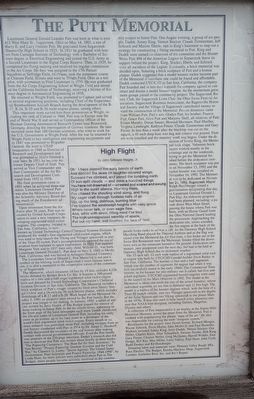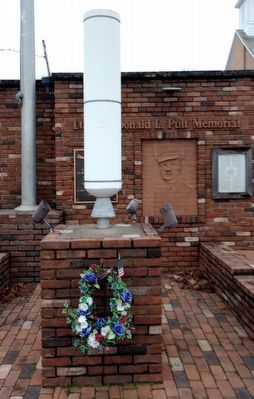Sugarcreek in Tuscarawas County, Ohio — The American Midwest (Great Lakes)
The Putt Memorial
Lieutenant General Donald Leander Putt was born at what is now 412 West Main St., Sugarcreek, Ohio on May 14, 1905, a son of Harry E. and Lucy Pressler Putt. He graduated from Sugarcreek-Shanesville High School in 1923. In 1928 he graduated with honors from Carnegie Institute of Technology with a Bachelor of Science degree in Electrical Engineering and joined the U.S. Army as a Second Lieutenant in, the Signal Corps Reserve. Then, in 1929, he completed his flying training and received his regular commission in the Air Corps. He then was assigned to the 17th Pursuit Squadron at Selfridge Field, Michigan, took the armament course at Chanute Field, Illinois and went to Wright Field, Ohio as a test pilot, with promotion to First Lieutenant in 1935 He was graduated from the Air Corps Engineering School at Wright Field and attended the California Institute of Technology, receiving a Master of Science degree in Aeronautical Engineering in 1938.
He returned to Wright Field, was promoted to Captain and served in several engineering positions, including Chief of the Experimental Bombardment Aircraft Branch during the development of the B-17, B-24, B-29 and B-36 multi-engine planes, among others.
This important work earned him three promotions at Wright, including the rank of Colonel in 1944. Putt was in Europe near the end of World War II and served as Commanding Officer of the Herman Goering Aeronautical Research Center near Brunswick, Germany, directing the interrogation of German scientists. He later recruited more than 160 German scientists, who went to work for the U.S. Government at Wright Field. After the war he returned to Wright Field in key intelligence and engineering assignments and in 1947 was promoted to Brigadier in 1947 was promoted to Brigadier General. He went to USAF heaquarters in 1948 as Director of Research and Development and was promoted to Major General a year later. In 1951 he became Assistant Deputy Chief of Staff. Putt served as Vice Commander and then Commander of the Air Research and Development Command from 1952 to 1958.
His final promotion came in 1953 when he achieved three-star status. Lieutenant General Putt was also the Military Director of the Scientific Advisory Board during much of the Eisenhower administration.
Upon retirement from the Air Force after 30 years, Putt was recruited by United Aircraft Corporation to start a new company developing segmented solid rocket engines. The company, located in San Jose, California, is now known as United Technology Center/Chemical Systems Division It produced the world's first segmented solid rocket engine, which was used to help launch the Viking and Voyager spacecraft as part of the Titan III rocket. Putt's accomplishments spanned the era of aviation from biplanes to space exploration. In 1933 Putt married Margaret Yent and in 1937 their only child, William D., was born. Lieutenant General Donald L. Putt died on Nov. 4, 1988 in Menlo Park, California, and was buried in Arlington National Cemetery The Lieutenant General Donald L. Putt Memo'ial is not just a symbol of the lifelong work of Sugarcreek's most-famous native son, it is also a memorial to the cooperative nature of the community of Sugarcreek.
The Memorial, which measures 14 feet by 19 feet, includes 4,234 bricks donated by Belden Brick Co. Inc. It features a 300-pound replica of a two-and-a-half stage segmented solid rocket engine built and donated by United Technology Corporation's Chemical Systems Division in San Jose, California. The Memorial includes a brick sculpture of Putt's visage, created by local artist Sherry Stingel Crilow and a 24-inch-by-30-inch bronze plaque, which includes sketchings of a B-17 and a B-29. Work began on the Memorial October 5, 1992 on property once owned by the Putt family. But the project was longer in the making. In January, 1992, a series of articles written by Jerry Dudek of The Budget piqued the interest of those looking to honor Putt. In the six-article series, appearing on the front page of the local newspaper each week Dudek chronicled the life and times of Lieutenant General Putt, including his early years as an aviator, up to his later years as a developer of the world's first segmented solid rocket engine. Every month or so, more research was published about Putt, including excerpts from an oral history conducted with Putt in 1974 by Dr. James C. Hasdorff. Dudek discovered the existence of the oral history after making contact with several governmental officials. Even the Putt family was unaware of the 250-page interview. Dudek's research also led him to discover that Putt was written about briefly in three books; "The Paperclip Conspiracy: The Hunt for the Nazi Scientists," by Tom Bower; "Project Paperclip: German Scientist and the Cold War," by Clarence G. Lasby; "Secret Agenda; The United States Government, Nazi Scientists and Project Paperclip, 1944-1990", by Linda Hunt. As more articles were published about Putt in The Budget, more people became actively involved in the community project to honor Putt. One August evening, a group of six people, Dudek, Sonny King, Vernon Stocker, Claude Zimmerman, Jeff Schrock and Maxine Eberle, met in King's basement to map out a strategy for constructing a fitting memorial to Putt. King and Dudek were named co-chairmen of the committee and the Homer Weiss Post 494 of the American Legion in Sugarcreek threw its support behind the project. King, Stocker, Eberle and Schrock were all members of the Legion. Eventually, a brick memorial was decided upon, featuring a brick sculpture of Putt and a bronze plaque. Dudek suggested that a model booster rocket become part of the Memorial if somehow one could be found and affordable. Dudek contacted UTC/CSD in San Jose, California, the company Putt founded and in less than a month the company agreed to construct and donate a model booster engine. As the momentum grew, more groups joined in the community project. The Sugarcreek Rotary Club, the Sugarcreek Lions Club, the Ohio Swiss Festival Association, Sugarcreek Business Association, the Ragersville Historical Society and the Village of Sugarcreek contributed money toward the construction of the Memorial. Private donations came from William Putt, Putt's son; Gladyn Putt, his brother; Francis Putt, Grace Putt, Alice Putt and Marjorie Shell, all relatives of Putt; Eileen Murphy, Doran Sauser, Howard Moomaw, Paul Mueller, Virginia Lembright, Kathryn Finzer. Claude Zimmerman and Gary Finzer. In less than a week after the blacktop was cut on the square, a 40-inch deep base was dug and cement was poured. Footers were installed and the masonry work was begun. Under the direction of Sonny King, the Memorial took shape. Volunteer bricklayers worked mostly in the evenings and on the weekends, trying to get the Memorial finished before the dedication ceremony. The brick sculpture was put in on November 13, 1992 and the rocket booster was installed on November 16, 1992. The Memori- al was to be dedicated on November 21, 1992. Sugarcreek Mayor Ralph Hershberger issued a proclamation designating that day as Lieutenant General Donald L. Putt Day. An elaborate program had been planned, including: a parade down West Main Street, passing the house where Putt was born, with an Honor Guard from the Ohio National Guard leading the procession. Approaching the dedication site, sirens sounded, the fire engine at the back of the parade broke ranks to answer a call. As the Garaway High School Marching Band played the National Anthem and as the flag was raised over the Memorial for the first time, a fire broke out at the Swiss Hat Restaurant near the Memorial. Smoke filled the downtown area as the restaurant burned to the ground. Dedication ceremonies vere postponed until the next day, but had to be held at Garaway High School due to inclement weather.
The 55-inch tall, 12-inch wide replica of a segmented solid rocket engine was built by UTC/CSD's model builder Dave Bailey in San Jose, California. The booster is two-and-a-half segments, which was the number of segments the engine had when it was first successfully tested in the early 1960s, The Commercial Titan booster, as the booster for non-military use is called, has five-and-a-half segments. UTC/C8D segmented booster engines were used in the launch of the Mars Observer in 1992. The model at the Memorial is about one-tenth the size of the actual boosters, whose individual segments are ten feet in diameter and 12 feet high. The model is a replica of the booster engines which, with the help of a Titan III launch vehicle, sent two Voyager spacecraft to the depths of the Solar System and two Viking spacecraft to the planet Mars in the 1970s. It was also used to help launch every planetary mission that NASA ever designed, including Galileo, Magellan, Ulysses and others.
A collection of Putt memorabilia is on display at the Alpine Hills Historical Museum, across the street from the Memorial. Putt is credited with popularizing the phrase "state of the art." He also was responsible for coining the term "weapons system."
Bricklayers for the project were Doran Immel, Richard Menges, Wayne Schrock, Ervin Mullet, John Mullet Jr. and Paul Hostetler. Workers included Sonny King, Jerry Dudek, Vernon Stocker, Ora Miller, Charles Klein, Atlee Schupbach, Ferman Snyder, Bob King, Gary Finzer, Clayton Weller, Greg McQueen, Harold Widder, Don Dodge, Bill Ray, Max Miller, Larry Yakley, Paul Shutt, John Croft, Budd Deuker and Ed Honabarger.
Donating labor and materials were: Pleasant Valley Ready Mix, Russ Electric, The Budget, Eureka Machine Shop, Sugarcreek Lumber, Soehnlen Bros. Inc. and Ike's Repair.
High Flight Oh I have slipped the surly bonds of earth
by John Gillespie Magee, Jr.
And danced the skies on laughter-silvered wings;
Sunward I've climbed, and joined the tumbling mirth
Of sun-split clouds -- and done a hundred things You have not dreamed of -- wheeled and soared and swung
High in the sunlit silence. Hov'ring there,
I've chased the shouting wind along, and flung
My eager craft through footless halls of air.
Up, up the long, delirious, burning blue
I've topped the windswept heights with easy grace
Where never lark, or even eagle flew.
And, while with silent, lifting mind I've trod
The high-untrespassed sanctity of space,
Put out my hand, and touched the face of God.
Topics. This memorial is listed in these topic lists: Air & Space • Military.
Location. 40° 30.197′ N, 81° 38.464′ W. Marker is in Sugarcreek, Ohio, in Tuscarawas County. Memorial is at the intersection of West Main Street and North Broadway Street, on the right when traveling west on West Main Street. Touch for map. Marker is in this post office area: Sugarcreek OH 44681, United States of America. Touch for directions.
Other nearby markers. At least 8 other markers are within 5 miles of this marker, measured as the crow flies. Lt. Gen. Donald L. Putt, U.S.A.F. (here, next to this marker); Milton Blickensderfer (here, next to this marker); Tom F. Miller (here, next to this marker); Giant Cuckoo Clock (within shouting distance of this marker); Flame of Freedom (approx. 0.8 miles away); History of Shanesville (approx. 0.8 miles away); Peace Bridge (approx. 4˝ miles away); Jonas Stutzman (approx. 4.7 miles away). Touch for a list and map of all markers in Sugarcreek.
Credits. This page was last revised on March 4, 2024. It was originally submitted on February 13, 2024, by Craig Doda of Napoleon, Ohio. This page has been viewed 64 times since then. Photos: 1, 2. submitted on February 13, 2024, by Craig Doda of Napoleon, Ohio. • Devry Becker Jones was the editor who published this page.

